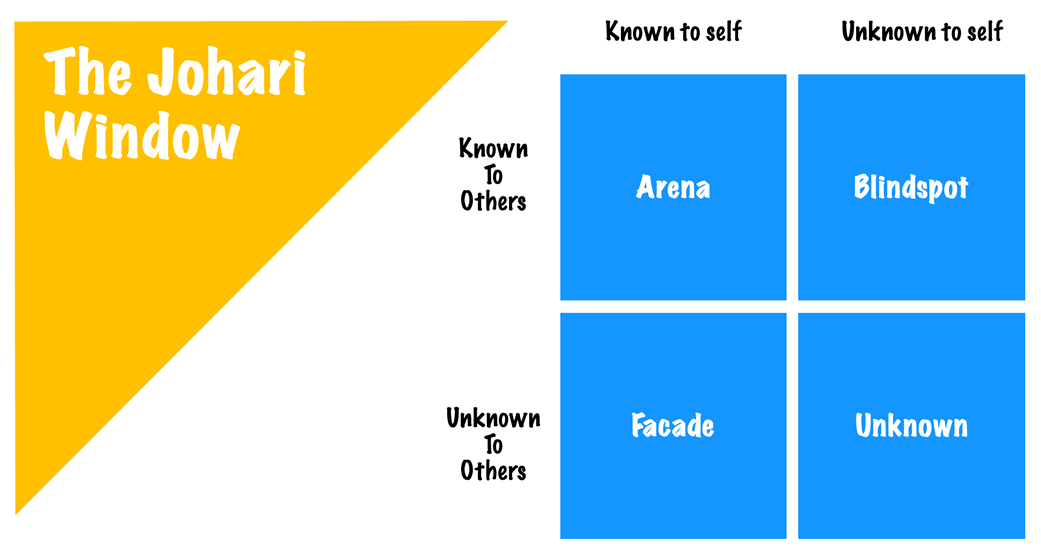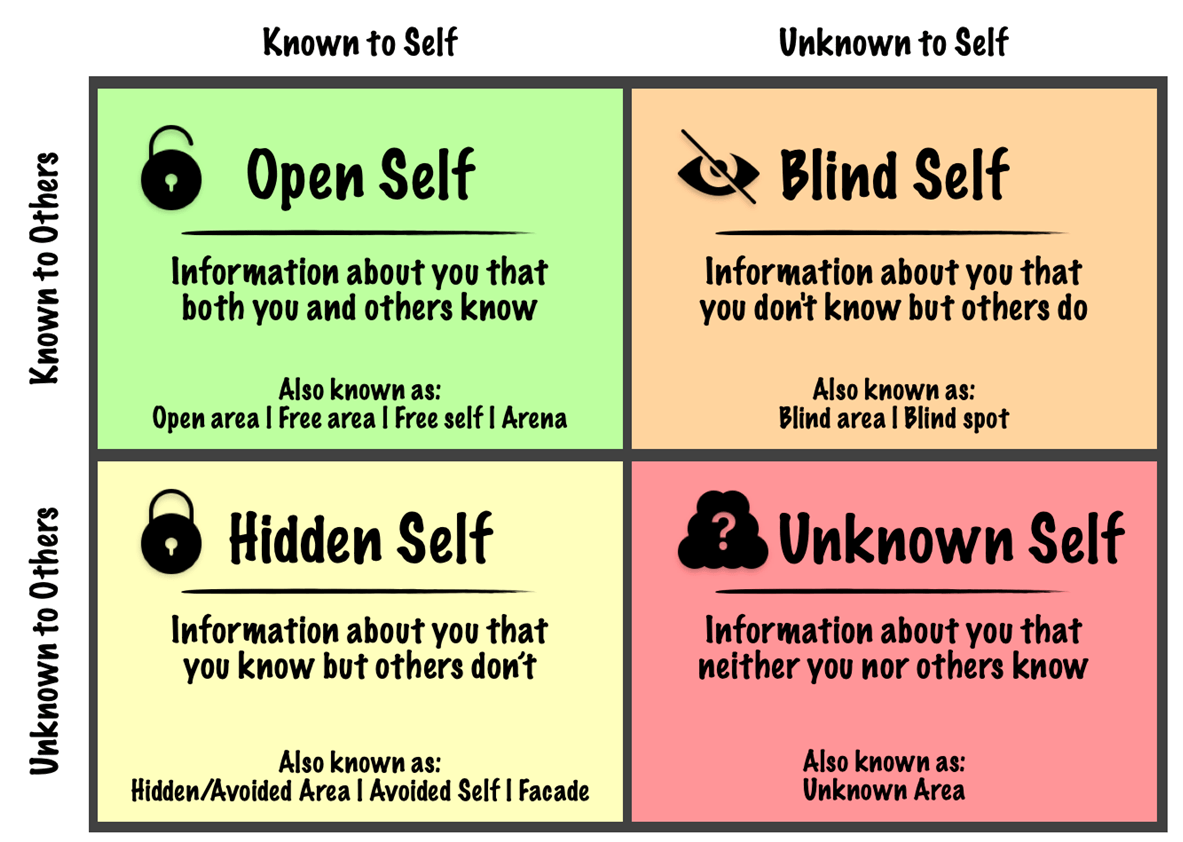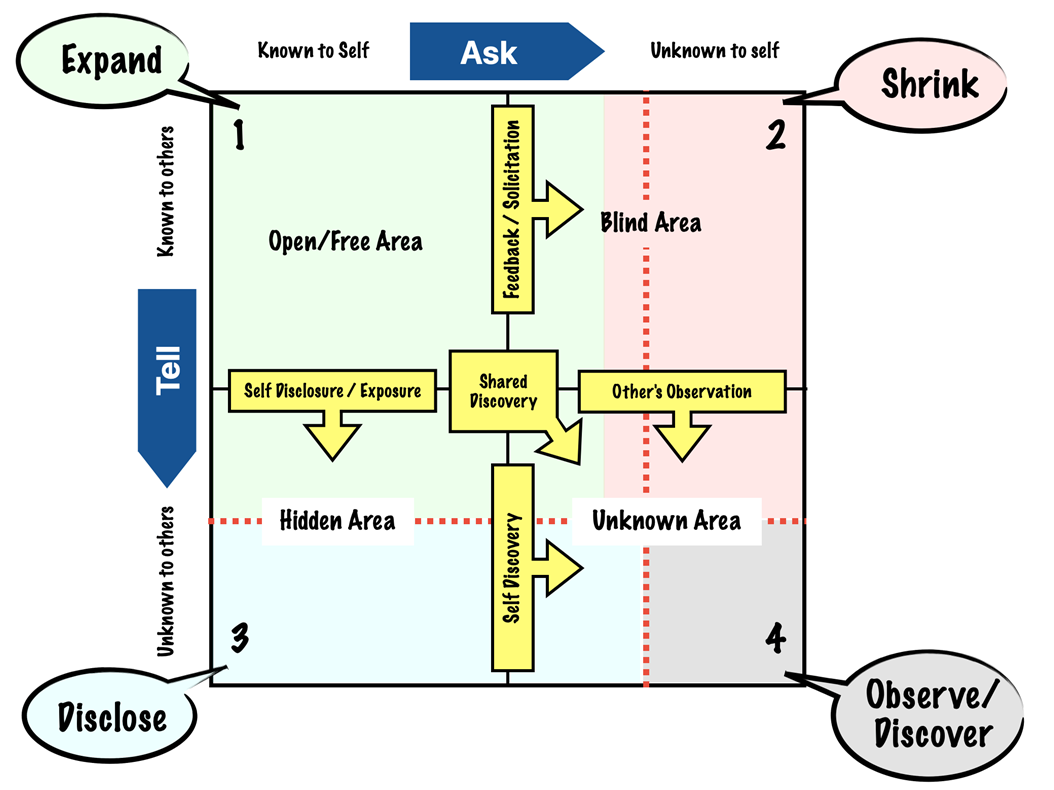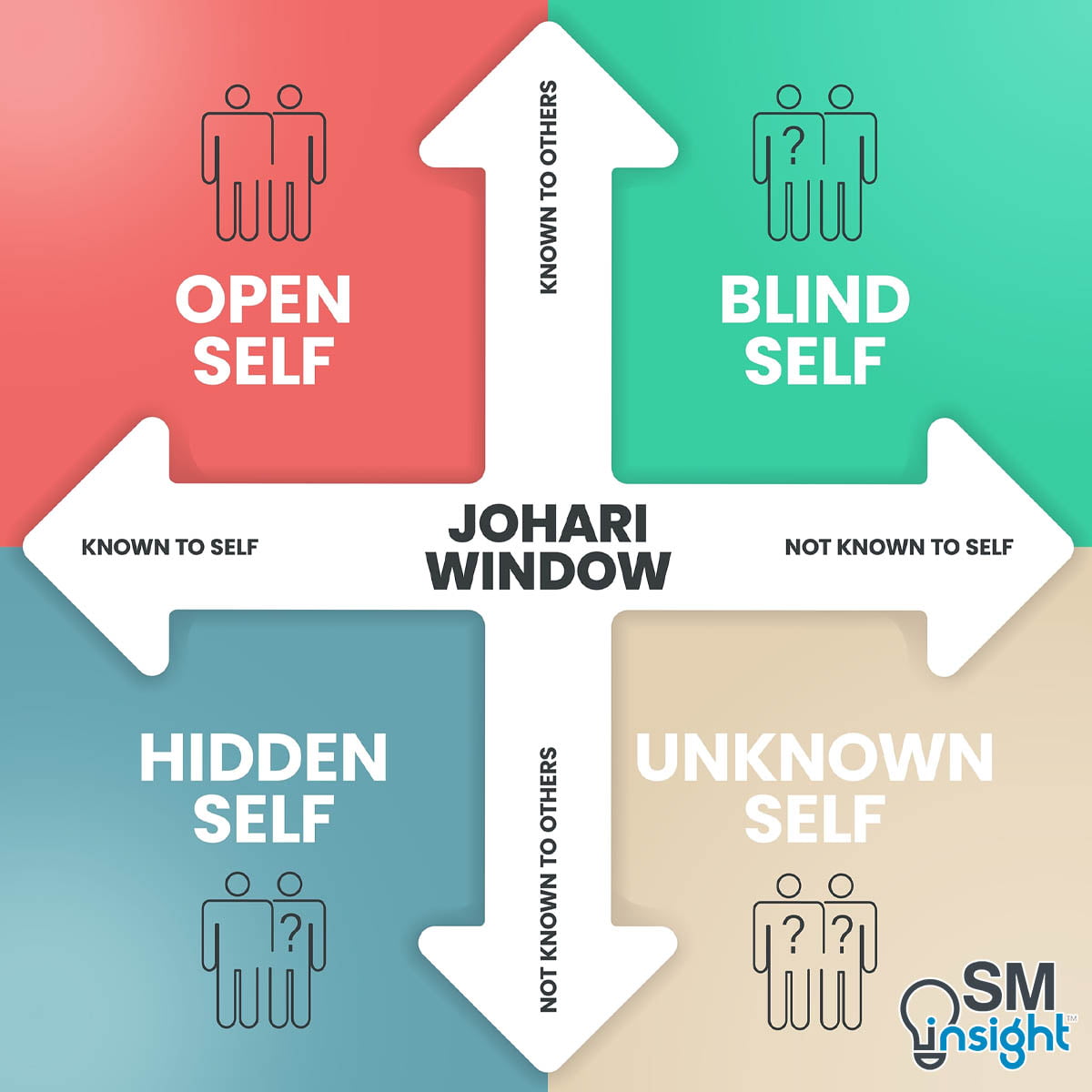What is the Johari Window
The Johari Window is a conceptual tool for illustrating the interaction between what is known/unknown to oneself and to others. It helps people better understand their relationship with themselves and others.
When two parties interact, they initiate a relationship whose quality is determined by the contributions each makes and how these contributions are received by the other. An adequate degree of self-knowledge and substantial self-disclosure is essential to the development and maintenance of a sound interpersonal relationship.
These dimensions of an individual’s impact on the exchange of such information have been combined in and popularly expressed by a 2 x 2 matrix labeled the Johari Window[1].

The model is also known as the “feedback/disclosure model of self-awareness” or “information processing tool”[3].
Johari Window was devised in 1955 by American psychologists Joseph Luft and Harry Ingham while researching group dynamics at the University of California and derives its name by combining the names of its authors, Joseph” and ‘Harry.
Why use the Johari Window
Johari Window can be used for improving self-awareness, personal development, communications, interpersonal relationships, group dynamics, team development, and inter-group relationships.
The existence of healthy social relations is a psychological need, and the happiness of people depends on the extent to which this need is met. Communication plays an important role, where often, the quality of social support a person offers to another depends upon the information they reveal about each other.
The information an individual reveals about oneself during his/her attempts to create new relationships provides the ground for building trust, warmth, and acceptance. Conversational patterns are related to the level of intimacy between people.
This is also known as the principle of reciprocity, according to which, as long as the person gives information about himself/herself and shows closeness to the other person, the other person will reciprocate likewise[1],[2].
The Johari Window helps individuals develop internal and external self-awareness and thus enables information sharing. Through this, the model supports the creation of trust in interpersonal relations and establishes open lines of communication among team members.
Relevance in Business
In organizations, the effectiveness of one’s leadership is often limited by his/her self-awareness. Improving self-awareness will help one listen, be more present and be in tune with the person or the group one is leading.
The Johari Window model helps a person become aware of how others see him/her in contrast to how the person sees himself/herself. In an ideal situation, there is a perfect alignment between both, but unfortunately, the reality is never ideal.
A common outcome is a difference between how one sees him/her vs how others see him/her. There may be things important to one that others are unaware of. There may also be values one demonstrates that other people see but one is not aware of.
The Johari window helps create this awareness. With this knowledge, one can work to expand one’s open area to close the gap between “self-view” and “how others perceive”.
The four quadrants of the Johari window
The Johari window model is based on two ideas:
- Acquiring trust by sharing information about oneself with others
- Learning about self from others’ feedback.
The model depicts a window with four “panes” through which communication flows as one gives and receives information. The window represents “information” such as feelings, experiences, views, attitudes, skills, intentions, motivations etc within or about a person in relation to the four perspectives.
In the diagram, ‘self’ refers to oneself (the person who is under study). ‘Others’ refers to people who know the person from various day-to-day interactions. The four “panes” are called regions or quadrants or areas. Each of the regions represents information known or unknown to the individual and known or unknown to others as shown:

The premise behind the window is that there are certain things that we know and things we do not know about ourselves. Similarly, there are certain things others know and do not know. Thus, at any given point, our true self is a combination of these four “panes” represented by the Johari window.
In the diagram, all panes look equal, but the size (or openness) of each pane will vary depending on how well:
- One knows oneself
- One shares about oneself with others
- Others know the person
How the Johari Window Works
Expanding the Open Area:
Organizational teams using the Johari window must strive to expand the Open area for each team member. This allows individuals to operate in their most productive and effective space and as a group. Addressing this area results in open, honest, & transparent communication and minimizes mistrust & confusion.
In a Johari Window, the size of the open area can be expanded in two ways:
- Horizontal expansion into the blind space by seeking and actively listening to feedback from other group members. (known as ‘feedback solicitation’).
- Vertically downwards into the hidden or avoided space by the person’s disclosure of information, feelings, etc. about him/herself (known as self-disclosure/exposure)
Teams can help a member expand their open area by offering feedback, though sensitively. Group members can help a person expand their open area into the hidden area by asking the person about him/herself.
New team members often have smaller open areas than established ones. They need time to learn about others and to share information about themselves. The Johari Window can serve as an important instrument in establishing a culture of open communication.
Managers and team leaders can facilitate feedback and encourage disclosures through indirect feedback to individuals about their own blind areas. Developing a culture of open positive communication that encourages the positive development of the ‘open area’ or ‘open self’ for everyone is a simple yet fundamental aspect of effective leadership.
Shrinking the Blind Area
The Blind area represents information that is known about a person to others but is not known to the person himself/herself.
A blind area is not an effective or productive space for individuals or groups to be in. It could also reflect ignorance about oneself or issues in which one is deluded. A blind area could also include issues that others are deliberately withholding from a person and relate to the difficulty one experiences when being “kept in the dark.”
This can be addressed by soliciting and being open to feedback. The result is increased awareness about how others perceive oneself and the expansion of one’s open area. As a result, stronger communication and trust are established.
Managers should promote a climate of non-judgmental feedback and group response to individual disclosure, which reduces fear and therefore encourages both processes to happen. The extent to which an individual seeks feedback and the issues on which feedback is sought must always be left to the individual’s own discretion.
Addressing the Hidden Area
The hidden area represents information that a person intentionally hides from others. This could also include sensitivities, fears, hidden agendas, manipulative intentions, and secrets – anything that a person knows but does not reveal.
As a person’s trust grows, they will increasingly disclose greater information, thereby closing this window and enlarging the Open window.
By making disclosures about how we feel and other information about ourselves, we convert parts of the hidden area into the open area. This enables better understanding, cooperation, trust, team-working effectiveness, and productivity and reduces the potential for confusion, misunderstanding, and poor communication which distracts and undermines team effectiveness.
Organizational culture and working atmosphere have a major influence on the group members’ preparedness to disclose their hidden selves. Most people fear judgement or vulnerability and, therefore, hold back hidden information and feelings.
Discovering the Unknown Area
The Unknown area represents information, feelings, latent abilities, aptitudes, and experiences that are neither known to the person nor to others in the group. Large unknown areas would typically be expected in younger people and people who lack experience or self-belief.
Examples of unknown factors are as follows (the first example is particularly relevant and common, especially in typical organizations and teams):
- An ability that is under-estimated or un-tried through lack of opportunity, encouragement, confidence, or training.
- A natural ability or aptitude that a person does not realize they possess.
- A fear or aversion that a person does not know they have.
- An unknown illness.
- Repressed or subconscious feelings.
- Conditioned behaviour or attitudes from childhood.
There are several processes, such as self-discovery, observation by others, and collective or mutual discovery, by which this information and knowledge can be uncovered.
Organizations that promote a culture of self-discovery and learning create opportunities for employees to close this window as they develop greater self-awareness. Creating a culture, climate and expectation for self-discovery helps people to fulfill more of their potential and thereby to achieve more, and to contribute more to organizational performance.
Using the Johari Window
To use Johari Window effectively, one must follow a two-step approach:
Step 1: Self-discovery
Start with the open area. Make notes about yourself.
- What are the strengths and the weaknesses?
- What are you comfortable with and willing to share with others?
- Use five or six adjectives to describe yourself (refer to the list below).
| able | confident | idealistic | modest | religious | spontaneous |
| accepting | dependable | independent | nervous | responsive | sympathetic |
| adaptable | dignified | ingenious | observant | searching | tense |
| bold | empathetic | intelligent | organized | self-assertive | trustworthy |
| brave | energetic | introverted | patient | self-conscious | warm |
| calm | extroverted | kind | powerful | sensible | wise |
| caring | friendly | knowledgeable | proud | sentimental | witty |
| cheerful | giving | logical | quiet | shy | |
| clever | happy | loving | reflective | silly | |
| complex | helpful | mature | relaxed | smart |
It is important to be honest & clear. Categorize the results into the four Johari Window Quadrants.
Step 2: Involving others and seeking feedback
Ask a diverse set of people to select five to six adjectives (from the list) that they think best describe who you are. Consider the feedback seriously and duly acknowledge people for making the effort to provide feedback.
Depending on how confident one is, this can either be a group exercise or on a one-to-one basis. When receiving feedback, it is important to be respectful, to listen and reflect on what has been said.
Categorize the feedback into the four Johari Window Quadrants. Discuss the results with the group to elicit deeper insights.
Interpreting adjectives in the Johari Window quadrants
There exists a shifting balance between the four quadrants of a Johari window, as shown:

The adjectives in each Johari Window (JW) quadrant can be decoded as follows:
The Open Quadrant
These are the adjectives selected by both self and others. In an ideal outcome, this area is large which demonstrates that a person’s behaviors are in alignment with how he/she wants to be perceived.
To increase the open area, one can start by sharing more. If there is a value in the hidden area, one can focus on sharing that information with the team. The goal is to expand the open area.
The Blind Quadrant
These adjectives are chosen by the team and represent how others see the person, but the person himself is not aware of these adjectives.
Items in the blind spot offer a great opportunity to learn and increase self-awareness. It is important to approach these items with curiosity, not defensiveness.
Three typical scenarios that lead to the blind spot:
- The relationship is new or shallow – other team members don’t know who you are. This is an opportunity to share more about yourself and learn how they have perceived you. The simple act of discussing your values can create better alignment.
- Your desired identity does not align with your behavior – People perceive you based on your behaviors. Ask questions to learn more about the perspectives. What behaviors have I adopted that led to your choice?
- You have strengths others see but you are not aware of – a great opportunity to learn more about areas you can amplify and develop.
All items in the blind spot are an opportunity to learn.
The Hidden Quadrant
These are adjectives selected by a person but not by any of his/her peers. It is common for the hidden area to be larger in new relationships, but it can be surprising when it is still large in a long-term relationship.
This helps to surface false assumptions and misunderstandings about a person. The hidden area can reveal a deeper insight and the fact that how one sees oneself is inconsistent with how one behaves.
The ideal outcome is to move items from the hidden area into the open. This can be achieved by sharing more about hidden traits with the group. It is important to reflect on what behaviors one can adopt that better demonstrate his/her ideal traits.
One must dig deeper by asking more about what one can do to demonstrate more of these traits.
The Unknown Quadrant
Any adjectives not selected go into the Unknown. This could be because they simply do not apply or because the people selected have not seen these traits demonstrated.
Over time, these adjectives might move, especially as one engages with different people in the organization.
Limitations of Johari Window
The Johari Window does have certain limitations that should be considered:
Confidentiality Concerns: Not everything may be suitable for communication with others. Sharing sensitive or private information might not be appropriate or beneficial for the individuals involved.
Information Dissemination: When individuals disclose information within the Johari Window framework, there is a possibility that this information could be passed on to others without their consent.
Negative Use of Information: may be used in ways that are detrimental or harmful to the person who disclosed it. This risk becomes more significant when dealing with individuals who might exploit the information for personal gain or to manipulate others.
Cultural Differences: Cultural norms play a significant role in how people give and receive feedback. Some cultures encourage open and candid feedback, while others may value discretion and indirect communication. These cultural variations can influence the effectiveness and acceptance of the Johari Window model in different settings.
Emotional Responses: Receiving personal feedback can be challenging and individuals may react defensively or negatively. This emotional response can hinder the constructive nature of the Johari Window process, making it difficult to achieve genuine self-awareness and growth.
Sources
1. “The Johari Window: A Reconceptualization”. John W. Newstrom and Stephen A. Rubenfeld, https://absel-ojs-ttu.tdl.org/absel/index.php/absel/article/view/2298 Accessed 28 Jul 2023
2. “Of Human Interaction: The Johari Model by Joseph Luft”. Joseph Luft , https://www.amazon.com/Human-Interaction-Johari-Joseph-1969-06-03/dp/B01FKU1NY6 Accessed 28 Jul 2023
3. “The Transparent Self”. Sidney M. Jourard , https://www.amazon.com/Transparent-Self-Sidney-M-Jourard/dp/0442241933 Accessed 27 Jul 2023
4. “Taking turns: Reciprocal self-disclosure promotes liking in initial interactions”. Journal of Experimental Social Psychology, https://www.sciencedirect.com/science/article/abs/pii/S002210311300070X Accessed 27 Jul 2023
5. “How To Use Johari Window To Build Self-Awareness”. TOBY SINCLAIR, https://www.tobysinclair.com/post/how-to-use-johari-window-to-build-self-awareness Accessed 28 Jul 2023
6. “The Johari Window Model”. Pankaj Setiya, https://cab.rbi.org.in/docs/elearning/Handouts/Johari_Window.pdf Accessed 27 Jul 2023


Is anyone offering the Johari Windows as a group team building excerscise?